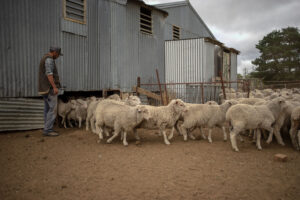While the merino market has come off the boil since mid-2022, as have apparel fibre markets generally, the very fine end of the merino micron distribution continues to sell at high price levels. Today, we examine the relationship between at 14 and 15 micron prices and volumes.
Prices and supply at the edge of the merino micron distribution can swing wildly due to cyclical changes in the micron distribution (supply) and in demand. Beyond these cyclical changes there has been a structural change in the price structure of these finer micron categories in response to increased supply during the past three decades.
Figure 1 shows the annual (wool selling season) supply and average 14 micron (13.6 to 14.5 micron) price (all in) from 1995-96 to the current season (where the change in supply for the season to date is used to develop a full season estimate based of last season volumes). To arrive at supply AWEX sales data has been used until 2000-2001 and from there onwards AWTA core test volumes have been used (in conjunction with auction derived yield data for the micron categories in question).
The key message of Figure 1 is that the decline in price as supply starts to increase. This is the big structural change which has taken place at the very fine end of the merino distribution in recent decades. The decline lasted to around the 2005-2010 period as supply climbed from around 2 tonnes clean per season to 70-90 tonnes. Supply peaked at 310 tonnes in 2018-19 and is not back to around half of that level, so volatility is supply continues.
With this structural change in mind Figure 2 takes the data from Figure 1, starting at 2005-2006. For the current season to date the average price (all lots included in the calculation) is down by 4%. Supply is down by 32% (so far) which will be helping hold prices up in the face of weaker economic activity generally.
Figure 3 creeps slightly broader, looking at the supply and average price for 15 micron wool. There is a similar structural change with prices crashing from around 2000 to 2005. Observant readers will note the 15 micron peak price is shown as being higher than the 14 micron price. This stems from a simple micron average price (all lots in) being used. Supply picks up in this period from around 40-50 tonnes per season to 500-700 tonnes.
Figure 4 looks at the data from Figure 3 from 2005-2006 onwards, ignoring the earlier market which was a different structure to the modern market. In Figure 4 there is some (negative) correlation between swings in the supply and variations in the annual price. When the trends are stripped out of both the price and supply, variations in supply from trend explains around 40% of the variation in price from trend. The lower supply, since 2019-2020, has played a definite role in helping to push prices up and hold them there.
What does it mean?
The message here is that supply plays an important cyclical role in determining 15 micron prices. The cyclcial effect is less so for micron categories finer than 15 micron. Structurally, the merino market for these finer merino micron categories has changed dramatically since the 1990s, with much increased supply driving prices much lower from the mid-1990s through 2005-2010. The structural change was common to all of the finer micron categories. Who says the wool market does not change?
Have any questions or comments?
Key Points
- Memories of the high prices for very fine merino wool in the 1990s still float to the surface occasionally but they have gone, unless supply collapses back to 1990 levels.
- For 15 micron swings in supply account for some 40% of swings in price (when trends are stripped out of the data).
- Supply for very fine merino wool has been lower in recent seasons in response to good seasonal conditions, which has helped support high price levels.
Click on figure to expand
Click on figure to expand
Data sources: AWEX, ICS
Photo Credit: Natasha hull
















